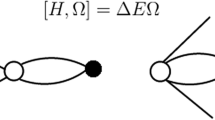Abstract
With the electronic part of the problem treated in the previous chapter, the nuclear motion shall occupy our attention in this one. In many ways the motion of two nuclei in a potential well formed by the electron cloud is among the simpler of all quantum mechanical problems. The reason is that it readily reduces to the motion of a single particle in a potential well. The derivation of how that comes about is given in detail in case some have not seen it before.
Access this chapter
Tax calculation will be finalised at checkout
Purchases are for personal use only
Similar content being viewed by others
Notes
- 1.
Spectra of Diatomic Molecules, 2nd ed. Gerhard Herzberg, Van Nostrand Reinhold, N.Y., 1950.
- 2.
Spectra of Diatomic Molecules, 2nd ed. Gerhard Herzberg, Van Nostrand Reinhold, N.Y. 1950.
- 3.
More recent numbers are compiled in Constants of Diatomic Molecules, K.P. Huber and G. Herzberg, Van Nostrand Reinhold, N.Y. 1979.
- 4.
R.L. Brooks and J.L. Hunt, J.Chem.Phys. 88, 7267 (1988).
Author information
Authors and Affiliations
Rights and permissions
Copyright information
© 2013 Springer Science+Business Media New York
About this chapter
Cite this chapter
Brooks, R.L. (2013). Vibrations and Rotations of Diatomic Molecules. In: The Fundamentals of Atomic and Molecular Physics. Undergraduate Lecture Notes in Physics. Springer, New York, NY. https://doi.org/10.1007/978-1-4614-6678-9_6
Download citation
DOI: https://doi.org/10.1007/978-1-4614-6678-9_6
Published:
Publisher Name: Springer, New York, NY
Print ISBN: 978-1-4614-6677-2
Online ISBN: 978-1-4614-6678-9
eBook Packages: Physics and AstronomyPhysics and Astronomy (R0)




